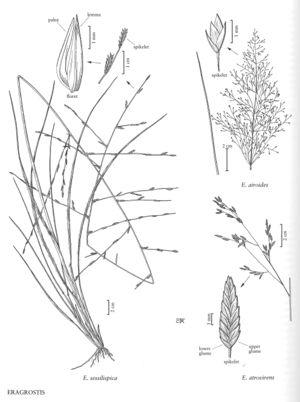Difference between revisions of "Eragrostis atrovirens"
FNA>Volume Importer |
imported>Volume Importer |
||
| (8 intermediate revisions by 2 users not shown) | |||
| Line 4: | Line 4: | ||
|publications= | |publications= | ||
|common_names=Thalia lovegrass | |common_names=Thalia lovegrass | ||
| + | |special_status={{Treatment/ID/Special_status | ||
| + | |code=I | ||
| + | |label=Introduced | ||
| + | }} | ||
|basionyms= | |basionyms= | ||
|synonyms= | |synonyms= | ||
| Line 17: | Line 21: | ||
-->{{Treatment/Body | -->{{Treatment/Body | ||
|distribution=Fla.;Ala.;Ga. | |distribution=Fla.;Ala.;Ga. | ||
| − | |discussion=<p>Eragrostis atrovirens is native to northern Africa, but it is now established in southeastern United States, where it grows along railways and roads, on beaches and in ditches, often in wet sandy soils and in association with Pinus, Taxodium, and Sabal.</p> | + | |discussion=<p><i>Eragrostis atrovirens</i> is native to northern Africa, but it is now established in southeastern United States, where it grows along railways and roads, on beaches and in ditches, often in wet sandy soils and in association with <i>Pinus</i>, <i>Taxodium</i>, and <i>Sabal</i>.</p> |
|tables= | |tables= | ||
|references= | |references= | ||
| Line 26: | Line 30: | ||
-->{{#Taxon: | -->{{#Taxon: | ||
name=Eragrostis atrovirens | name=Eragrostis atrovirens | ||
| − | |||
|authority=(Desf.) Trin. ex Steud. | |authority=(Desf.) Trin. ex Steud. | ||
|rank=species | |rank=species | ||
| Line 33: | Line 36: | ||
|basionyms= | |basionyms= | ||
|family=Poaceae | |family=Poaceae | ||
| + | |illustrator=Linda A. Vorobik;Cindy Roché | ||
| + | |illustration copyright=Utah State University | ||
|distribution=Fla.;Ala.;Ga. | |distribution=Fla.;Ala.;Ga. | ||
|reference=None | |reference=None | ||
|publication title= | |publication title= | ||
|publication year= | |publication year= | ||
| − | |special status= | + | |special status=Introduced |
| − | |source xml=https:// | + | |source xml=https://bitbucket.org/aafc-mbb/fna-data-curation/src/200273ad09963decb8fc72550212de541d86569d/coarse_grained_fna_xml/V25/V25_167.xml |
|subfamily=Poaceae subfam. Chloridoideae | |subfamily=Poaceae subfam. Chloridoideae | ||
|tribe=Poaceae tribe Cynodonteae | |tribe=Poaceae tribe Cynodonteae | ||
Latest revision as of 17:58, 11 May 2021
Plants perennial; cespitose, with innovations, without rhizomes, not glandular. Culms (60)75-130 cm, erect. Sheaths glabrous, apices hairy, hairs to 4 mm; ligules 0.1-0.3 mm; blades (5)8-20 cm long, (1)2-3(4) mm wide, flat to involute, abaxial surfaces glabrous, adaxial surfaces mostly scabridulous, long ciliate basally. Panicles (7)10-20(28) cm long, (2.5)4-15 cm wide, ovate, open; primary branches (3)5-10(13) cm, diverging 20-60° from the rachises, wiry, somewhat capillary, naked basally; pulvini glabrous or sparingly hairy, hairs shorter than 2 mm; pedicels 1-10 mm, appressed, scabridulous. Spikelets 5-10(19) mm long, 1.4-2.4 mm wide, ovate-lanceolate, plumbeous to purplish, with 10-22 florets; disarticulation acropetal, glumes first, then the florets. Glumes subequal, lanceolate to ovate, membranous; lower glumes 1.2-1.4 mm, narrower than the upper glumes; upper glumes 1.4-1.7 mm; lemmas (1.5)1.7-2 mm, broadly ovate, leathery, keels scabridu-lous, lateral veins evident, apices acute; paleas 1.4-1.9 mm, hyaline, bases not projecting beyond the lemmas, keels scabridulous, apices acute to obtuse; anthers 3, 0.7-0.9 mm, reddish-purple. Caryopses 0.6-0.9 mm, obovoid to ellipsoid, terete, opaque, somewhat striate, reddish-brown. 2n = 60.
Distribution
Fla., Ala., Ga.
Discussion
Eragrostis atrovirens is native to northern Africa, but it is now established in southeastern United States, where it grows along railways and roads, on beaches and in ditches, often in wet sandy soils and in association with Pinus, Taxodium, and Sabal.
Selected References
None.
